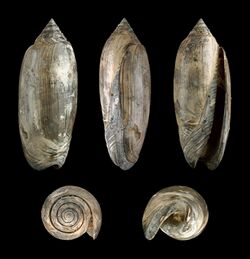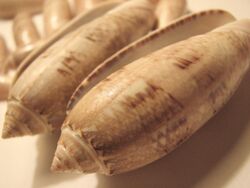Biology:Lettered olive
| Lettered olive | |
|---|---|

| |
| Scientific classification | |
| Domain: | Eukaryota |
| Kingdom: | Animalia |
| Phylum: | Mollusca |
| Class: | Gastropoda |
| Subclass: | Caenogastropoda |
| Order: | Neogastropoda |
| Family: | Olividae |
| Subfamily: | Olivinae |
| Genus: | Americoliva |
| Species: | A. sayana
|
| Binomial name | |
| Americoliva sayana (Ravenel, 1834)
| |
| Synonyms[1][2] | |
| |
The lettered olive, Americoliva sayana, is a species of large predatory sea snail, a marine gastropod mollusc in the family Olividae, the olive shells, olive snails, or olives.[3] It is sometimes referred to as Oliva sayana.[1]
Subspecies
(As of April 2010), the lettered olive contains the following accepted subspecies:[4]
- Oliva sayana sarasotensis Petuch & Sargent, 1986
- Oliva sayana sayana Ravenel, 1834
- Oliva sayana texana Petuch & Sargent, 1986
Distribution
The species' range is from North Carolina to Florida, the Gulf states of North America, including Louisiana and Texas ; and further south to the east coast of Mexico, including Campeche State, Yucatán State and Quintana Roo.[2][5] It may also occur in Brazil .[citation needed]
Habitat
The lettered olive typically lives in near-shore waters, on shallow sand flats near inlets. The empty shell is occasionally, or sometimes commonly, washed up onto ocean beaches.[citation needed]
Shell description
The shell of this species can be about 6 cm (2 1⁄4 in) long (maximum reported size reaches 9.1 cm[2]). It is a smooth, shiny, cylindrical-shaped shell with a short spire. The aperture is narrow and extending almost the length of shell, continuing around the bottom and ending in a notch on the other side. The suture is V-cut and deep. The lower part of the whorl is just above where the suture extends outward and then at a sharp shoulder drops into the suture.
The shell coloration can vary from cream to a greyish exterior with reddish-brown zigzag markings. The common name of this species is derived from the darker surface markings that sometimes resemble letters.
Life habits
Like all olives, the lettered olive is a carnivore: it captures bivalves and small crustaceans with its foot and takes them below the sand surface to digest.[6]
Its presence is sometimes detected at very low tides by the trails it leaves when it crawls below the surface on semi-exposed sand flats.[6]
Females lay floating, round egg capsules that are often found in beach drift. Young are free swimming.[6]
Human use
Colonists and early Native Americans made jewelry from these shells.[6]
The lettered olive is the state shell of South Carolina.[6]
References
- ↑ 1.0 1.1 "Americoliva sayana (Ravenel, 1834)". MolluscaBase. World Register of Marine Species. 2018. http://www.marinespecies.org/aphia.php?p=taxdetails&id=815494.
- ↑ 2.0 2.1 2.2 Malacolog 4.1.1: Western Atlantic Mollusk Species Database. Retrieved April 2010.
- ↑ Hardy, Eddie. "Oliva (Americoliva) sayana". http://www.gastropods.com/2/Shell_182.shtml. Retrieved 2018-11-28.
- ↑ Oliva sayana Ravenel, 1834. Retrieved through: World Register of Marine Species on 26 April 2010.
- ↑ "Observations of Americolivia sayana, Research Grade". https://www.inaturalist.org/observations&quality_grade=research&taxon_id=461554. Retrieved 2018-11-28.
- ↑ 6.0 6.1 6.2 6.3 6.4 Lettered Olive, NC Sea Grant
Wikidata ☰ {{{from}}} entry




